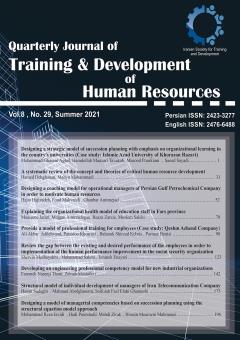Review the gap between the existing and desired performance of the employees in order to implementation of the human performance improvement in the social security organization
Subject Areas :SHERVIN MASHAYEKHI 1 , Mohammad salehi 2 , TARANEH ENAYATI 3
1 - Azad
2 - Azad
3 - Azad
Keywords: performancegap performancehuman performance improvement ,
Abstract :
performance analysis in organizations and identifying the gap of performance , its causes and roots is very important which can improve the quality of services of organizations , customer satisfaction and services . therefore , this study aims to identify the dimensions of employee performance gap in order to deploy human performance improvement in social security organization . this research has been done in terms of purpose among applied research and qualitative method . the statistical sample of this research includes 120 experts ( academic and organizational ) and data collection tool is taking notes from texts , theoretical studies and available models . the results indicate that performance gap can be divided into three aspects : leadership style , workplace and human resource management . based on the findings in the first dimension , components of strategic management , structure , processes , style of management and interests of stakeholders , in the second dimension , components of organizational culture , environmental conditions , data and information and finally in the third dimension , components of human resource management , individual competencies , service system and compensation were confirmed . furthermore , by confirming the final model of performance gap , the stages of human performance improvement were identified in five stages .
Talbot, C. (2010). Theories of performance: Organizational and Service Improvement in the Public Domain. Oxford University Press.
Enos D. (2007). Performance Improvement: making it happen. New York: Taylor & Francis Group.
Addison R M, Haig C. (2006). The Performance Architect’s Essential Guide to the Performance Technology Landscape. In J. A. Pershing (Ed.). Handbook of human performance technology: principles, practices and potential (3rd Ed.). (pp. 35-54). San Francisco, Pfeiffer.
Rossett A. (2006). Analysis and More. In J. Pershing (Ed.). Handbook of Human Performance Technology: Principles, Practices and Potential (3rd Ed.) (pp. 208-222). San Francisco, Pfeiffer.
Fasset. Gap (2002) Analysis Report. Gauteng: Management Consulting Learner ship Project.
Khoshmashraban Z. (2013). Designing the implementation of a human performance technology (Hpt) model: A study in Sina Bank. Master's Degree, Tehran University.
AHRQ. (2018). Gap Analysis. Pediatric Toolkit for Using the AHRQ Quality Indicators. Rockville: Agency for Healthcare Research and Quality.
Russell-Brown P. (2016). Gap Analysis; Final Report. Kingston: Ministry of Health.
Center for Public Health Leadership. (2014). Gap Analysis. Harvard: School of Public Health.
UCLA Health. (2016). Course Planning Tip Sheet: Gap Analysis. Los Angeles: UCLA Nursing.
WHO. (2013). Gap Analysis. Pandemic Influenza Preparedness Framework Partnership Contribution. Geneva: World Health Organization.
Mohammadi Sabet M, Fayyazi B, Shah Hoseini M. (2016). Designing a model for human performance technology: A study in SAPCO. Iranian journal of management sciences; 42 (11): 99-124.
Rezaee M. (2014). Review the gap between the existing and desirable performance of the Balanced Scorecard system: A study in National Iranian Copper Industries Co (nicico). International Conference on Economic Management Accounting and Social science. May 31. Rasht Iran.
Noe, R.A. (2008). Employee Training and Development. Boston, MA: Irwin/McGraw-Hill.
Sugrue, B. & Rivera, R.J. (2008). 2005 State of the Industry Report, Alexandria, VA: American Society for Training and Development.
Khorasani, A., vafaiezade, M, (2017) Human Performance Technology (HPT), Basics and
Principles, Tehran, Master's Science. Rothwell, W.J. (2005). Beyond Training and Development: The Groundbreaking Classic on Human Performance Enhancement. American Management Association.
Piersol, W. J & Paris, C. (2007). Human Performance Technology. A Discipline to Improve C2 Concept Development and Analysis klett consulting group Virginia Beach va.


